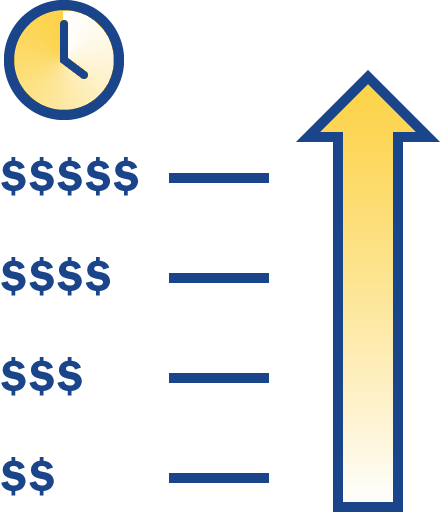Design
Forward Auction Design
The FCC has been conducting auctions to license spectrum rights for more than 20 years. However, the forward auction piece of the incentive auction will differ from the typical spectrum auction in that the number and locations of licenses available will depend upon the results of the reverse auction. The FCC will use innovative new approaches to auction design to manage this interrelationship and integrate the different auction components.
Band Plan
600 MHz Band Plan
The 600 MHz band plan adopted by the Commission maximizes the value of spectrum to potential bidders and provides both larger and smaller bidders a fair opportunity to acquire spectrum. Specifically the band plan consists of paired uplink and downlink bands (which enables two-way communications), offered in 5+5 megahertz blocks across 416 market areas called Partial Economic Areas ("PEA"). In a few markets where there the post-auction TV band is not large enough to accommodate every station, stations may be assigned a channel in the wireless band. In this way, the band plan accommodates limited variation in the amount of spectrum recovered from broadcasters in different geographic areas and prevents the “least common denominator market” from limiting the quantity of spectrum we can offer generally across the nation.

The band plan incorporates technically reasonable guard bands, including a uniform duplex gap (a special guard band used to separate uplink and downlink spectrum), to prevent harmful interference between licensed services.
Consistent with the Spectrum Act, and recognizing that unlicensed spectrum is a catalyst for innovation that provides economic value to businesses and consumers alike, the Commission determined that a portion of these guard bands would be available for unlicensed use nationwide by white space devices and unlicensed wireless microphones. In addition, at least one unused television white space channel in each area following the incentive auction will also be available for unlicensed devices as well as wireless microphone use.
To facilitate wireless microphone use of available spectrum in the reorganized UHF band, the Commission authorized wireless microphones licensed to broadcast and cable programming entities to operate in a 4 MHz portion of the duplex gap.
Bidding
Forward Auction Bidding Process
 Participants in the forward auction will first bid, in the “clock phase,” for generic blocks of spectrum. Spectrum will be offered in two categories based on the amount of interference created by TV stations that must be assigned to the wireless band. Most licenses offered will be in “Category 1,” which consists of licenses with no or minimal impairment; “Category 2” will consist of licenses with greater impairments. Forward auction bidders will bid for a desired number of paired blocks of spectrum, by category, in a geographic market. There will be a separate clock price for each category in each geographic area. The prices generally will rise from round to round, as long as the demand for licenses exceeds their availability. Bidders still demanding licenses when the clock prices stop rising in every license category in every area will become winners of those licenses provided the final stage rule is satisfied. If the rule is not satisfied, those bidders will have an opportunity to make additional bids in an extended bidding round. Bidding for generic blocks is expected to speed up the forward auction, reducing the time and, therefore, the cost of bidder participation.
Participants in the forward auction will first bid, in the “clock phase,” for generic blocks of spectrum. Spectrum will be offered in two categories based on the amount of interference created by TV stations that must be assigned to the wireless band. Most licenses offered will be in “Category 1,” which consists of licenses with no or minimal impairment; “Category 2” will consist of licenses with greater impairments. Forward auction bidders will bid for a desired number of paired blocks of spectrum, by category, in a geographic market. There will be a separate clock price for each category in each geographic area. The prices generally will rise from round to round, as long as the demand for licenses exceeds their availability. Bidders still demanding licenses when the clock prices stop rising in every license category in every area will become winners of those licenses provided the final stage rule is satisfied. If the rule is not satisfied, those bidders will have an opportunity to make additional bids in an extended bidding round. Bidding for generic blocks is expected to speed up the forward auction, reducing the time and, therefore, the cost of bidder participation.
Winners of generic blocks will then have the opportunity to bid in a separate “assignment phase” for frequency- specific blocks within the categories of blocks won in the clock phase. For winners of generic blocks that do not bid in the assignment phase, the auction system will assign specific licenses. Final license prices will reflect the winning bid amounts from the clock bidding rounds as well as any adjustments from the extended bidding round and assignment phase.